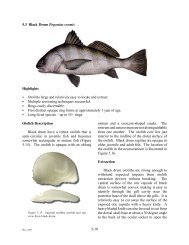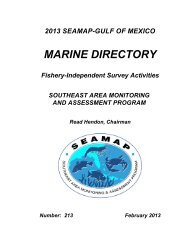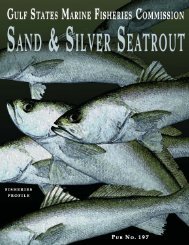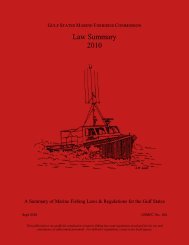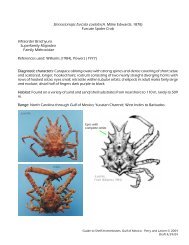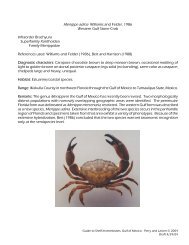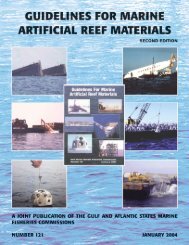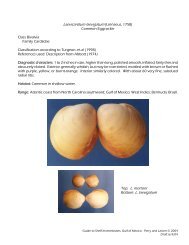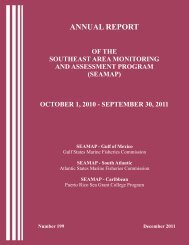Basic Commercial Fishing Regulations - Gulf States Marine ...
Basic Commercial Fishing Regulations - Gulf States Marine ...
Basic Commercial Fishing Regulations - Gulf States Marine ...
You also want an ePaper? Increase the reach of your titles
YUMPU automatically turns print PDFs into web optimized ePapers that Google loves.
Catfish<br />
Possession<br />
Limits<br />
The possession limit for catfish<br />
caught recreationally shall be 100.<br />
The 100 fish may be a single species,<br />
or a combination of blue, channel or<br />
flathead catfish. A recreational fisherman<br />
may possess a maximum of 25<br />
undersize catfish of a single or combination<br />
of all three species within the<br />
100 fish possession limit.<br />
Paddlefish<br />
Possession<br />
Limits<br />
Noxious Aquatic Plants<br />
Importation Prohibited<br />
Freshwater <strong>Fishing</strong><br />
The incidental take and possession of<br />
paddlefish is allowed under the following<br />
conditions: The taking or possession<br />
of paddlefish is closed in all<br />
saltwater areas of the state and in border<br />
waters shared with Texas. All possessed<br />
paddlefish must be dead. The<br />
possession or transportation of live<br />
paddlefish is prohibited. All paddlefish<br />
possessed on the waters of the<br />
state shall be maintained intact. No<br />
person shall possess paddlefish eggs<br />
on the waters of the state which are<br />
not fully attached to the fish. The<br />
daily take and possession limit of<br />
paddlefish is two per person. All<br />
paddlefish greater than 30 inches<br />
lower jaw fork length must be<br />
returned to the water immediately.<br />
(See section on “Measuring Fish” for<br />
an illustration).<br />
Releasing aquarium<br />
fish or unused bait<br />
into state waters is<br />
illegal.<br />
LDWF<br />
NOTICE TO FISHERMEN AND BOATERS<br />
With increasing frequency, introduced aquatic plants are<br />
creating serious aquatic habitat problems in many areas of<br />
the state. To minimize the spread of these plants in<br />
Louisiana waters we recommend the following: check<br />
boats (live wells, ice chests, fishing tackle, etc.) and trailers<br />
for the presence of aquatic vegetation prior to departing the<br />
launch site. If present, we encourage you to remove all<br />
plant material and dispose of it in a manner that will prevent<br />
introduction into other waterbodies.<br />
No person shall at any time import or cause to be transported into the jurisdiction<br />
of the state of Louisiana from any other state or country, any of the<br />
invasive noxious aquatic plants listed below, without first obtaining an<br />
Invasive, Noxious Aquatic Plant permit from the department:<br />
1. Eichhornia azurea (rooting<br />
or anchoring hyacinth)<br />
2. Elodea canadensis (elodea)<br />
3. Hydrilla spp. (hydrilla)<br />
4. Lagarosiphon muscoides &<br />
Lagarosiphon major (African<br />
elodea)<br />
5. Myriophyllum spicatum<br />
(Eurasian watermilfoil)<br />
6. Najas marina (marine naiad)<br />
7. Najas minor (slender naiad)<br />
8. Panicum repens (torpedograss)<br />
67<br />
9. Pontederia spp. (pickerelweed)<br />
10. Spirodela oligorrhiza (giant<br />
duckweed)<br />
11. Trapa (waterchestnut)<br />
12. Melaleuca quinquenvia (kapok<br />
tree)<br />
13. Pistia stratioties (water lettuce)<br />
14. Salvinia spp. (salvinia)<br />
15. Lythrum salicaria (purple loosestrife)<br />
16. Eichhornia crassipes (water<br />
hyacinth)<br />
17




